This was published 7 months ago
Gladys Knight, Empress of soul sings her final goodbye to Australia
By John Shand, Michael Ruffles, Bernard Zuel and Peter McCallum
SOUL/R & B MUSIC
Gladys Knight
The Star, March 30
★★★★
Reviewed by MICHAEL RUFFLES.
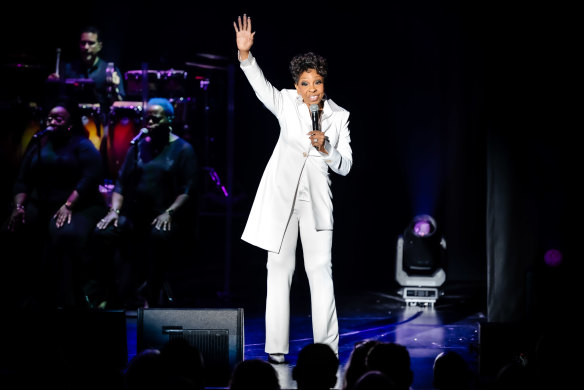
Gladys Knight on her farewell tour to Australia.Credit: Sunflower Sessions.
Gladys Knight’s licence to kill has no expiry date.
The Empress of Soul may not want to wield it forever, she’s called this The Farewell Tour after all, but when she aims for the heart she does not miss.
To the strains of the tight, bright band and soaring backing singers, Knight was helped on stage and smiled through much of the first minutes of her victory lap. Any sense of insecurity about the 79-year-old’s ability was soon dispelled with the funk-infused Baby, Don’t Change Your Mind.
Another early highlight was a rendition of Johnny Otis’ R&B classic Every Beat of My Heart, and Knight’s vocal trills and unabashed enthusiasm shone brightest as she shuffled around the stage in sapphire.
“I’m having too much fun, I’m supposed to be working,” she said at one point, then laughed and launched into a song about life’s ups and downs with all the gravitas and panache of a survivor.
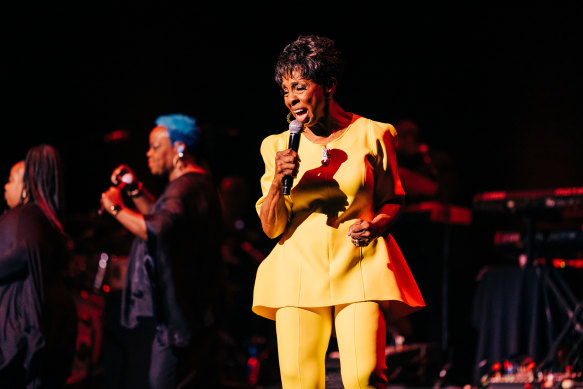
“I’m having too much fun, I’m supposed to be working,” Gladys Knight told the Sydney crowd on Saturday night.Credit: Samuel Graves
Knight’s rich and soulful timbre was perhaps on best display in the quieter moments, with the early parts of Oh! What a Love I Have Found especially moving, while the crescendo was a masterclass in vocal control.
As for her range and ability to pull off every note as she recorded them decades ago? Let’s just say she knows her instrument well and pulls the punches that are unlikely to land.
Bombastic Bond theme Licence to Kill felt a little forced at certain points, for example, although she sold it with a smile. It also had the unenviable task of following the terrific, funky I’ve Got to Use My Imagination, which was probably the most outright upbeat and fun song of the night alongside the classic I Heard it Through The Grapevine.
Being a farewell, the 1972 heartbreaker Neither One of Us (Wants to be the First to Say Goodbye) had extra poignancy as she sealed it with a kiss and wiped at a tear.
Better still was a cover of Barbra Streisand’s The Way We Were, for which Knight sat throughout and had the audience hanging on every whisper and inflection. In lesser hands it might have been mawkish, but from Knight’s lips the song sent shivers down spines and melted even cynical hearts.
After a triumphant, rocking Midnight Train to Georgia (1973) and a final loving wave, the Empress of Soul left an Australian stage for the last time by 9.45pm. Short, but ever so sweet, Knight left an indelible memory for those taking the T2 to Strathfield.
CLASSICAL MUSIC
Faure’s Requiem. Sydney Philharmonia Choirs.
Sydney Town Hall. March 28.
Reviewed by PETER McCALLUM
★★★½
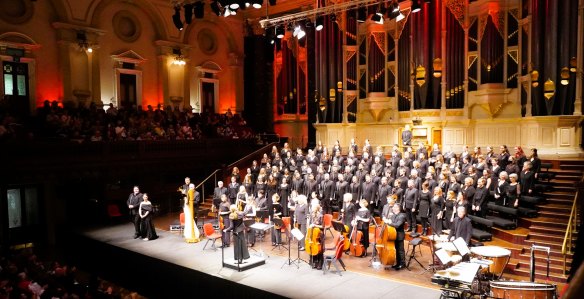
Sydney Philharmonia Choirs, perform Faure’s Requiem at the Sydney Town Hall.Credit: Simon Crossley-Meates.
After years working as organist at the imposing neoclassical church in Paris, La Madeleine, with its elaborate frieze of the day of judgment on the pediment, Gabriel Faure remarked that the clergy have “the best will in the world, and the worst taste”.
He had, as he remarked “had it up to here” with the funeral music he had been required to play, and, in his own Requiem, wanted to do something different. In the music he wrote there is no terror or judgment and wrath is only hinted at reassuringly. It is, as he put it in a letter to the great violinist Eugene Ysaye, “as gentle as I am myself”.
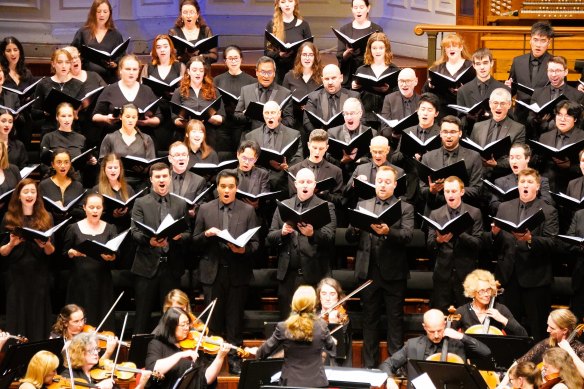
Elizabeth Scott conducts Sydney Philharmonia Choirs in Faure’s Requiem.Credit: Simon Crossley-Meates.
Laced with Faure’s gift for tender, unfettered melody and harmonic refinement, it is also extremely beautiful. This performance under conductor Elizabeth Scott by the Sydney Philharmonia Chamber Singers and the youth choir, Vox, captured that beauty and gentleness with a balanced, fresh choral sound, superb soloists in soprano Chloe Lankshear and baritone Andrew O’Connor, and, in addition to the intimately-sized orchestra of lower strings and horns, the rich Romantic resources of the Town Hall’s Hill Organ played by David Drury.
Although a little different in style from the organ by the distinguished French maker Aristide Cavaille-Coll that Faure played at La Madeleine, the Hill, completed in 1889, dates from exactly the time that the Requiem was composed.
Despite its fame, then and now, as the largest organ without electronic action in the world, it easily adapts in the hands of a skilled player like Drury to the subtleties of Faure’s small-scale orchestration while also opening out the sound palette with magnificent colour and breadth.
Highlights were the still clarity and purity of Chloe Lankshear’s sound in the exquisitely simple Pie Jesu, the noble solemnity and richness of Andrew O’Connor in the Libera me, the luminous choral tone in the Lux aeterna and the rounded shape of choral phrases in the In Paradisum.
After Deborah Cheetham Fraillon and Matthew Doyle’s musical acknowledgement of Country, Tarimi Nulay, the program began with John Peterson’s Shadows and Light. Originally written as a partner work to Mozart’s Requiem, the work, in three movements, eclectically mixes excerpts of Requiem text with more contemporary references and gestures from popular musical styles.
With jabbing propulsive rhythms in the music, and newspaper headlines from around 2001 in the text, the outer movements conjure a world on the skids where no-one cares. The central movement uses text by Japanese writer Jun-ichiro Tanazaki and deliberately cliched harmonic patterns to create a sustained mournful mood.
Lankshear was joined by tenor Andrew Goodwin for solo sections of polished lustre. As interlude Scott and violinist Fiona Ziegler led a reserved well-graded performance of Samuel Barber’s Adagio for Strings rising to a well-tuned climactic moment in high register.
MUSICAL THEATRE
WEST SIDE STORY
Handa Opera on Sydney Harbour, March 22
Until April 21
Reviewed by JOHN SHAND
★★★★
The sheer jolt of most artistic revolutions fades with time, until, retrospectively, they come to seem more like evolutions. Not West Side Story. Leonard Bernstein packed his score with such shocks and risks – such complex rhythmic syncopations and sudden dissonances – as had never stunned the usually safe and cutesy musical theatre stage before, with some of his most thrilling music coming not in the songs, but in the dance sequences. His music flattered a simple story with some complexity.
Nonetheless, the story was revolutionary in its own way. Romeo and Juliet in 1950s Manhattan, it might have been, but no one killed off the three male leads in this idiom in those days. Musical theatre and musical comedy were interchangeable terms. As Steven Sondheim’s father observed after reading the script and begrudgingly investing in the show, “Not many laughs, are there?”
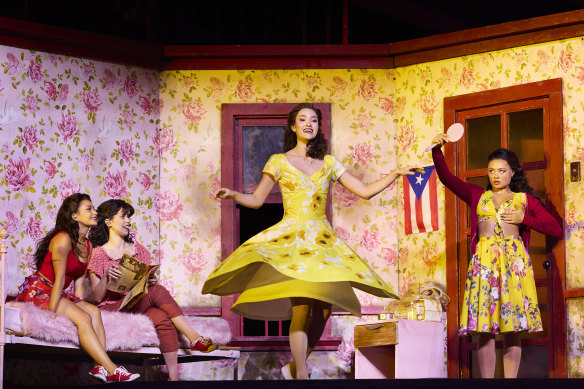
Nina Korbe as Maria (centre) captures a splendid sense of the giddiness of youth.Credit: Keith Saunders
The one failure of Bernstein, Sondheim (lyrics), Arthur Laurents (book) and Jerome Robbins (direction and choreography) was the glaring simplification of characterisation compared with Shakespeare’s crew. The upshot is that it falls to the lead performers to make something of the archetypes; to make you care.
In that regard, this revival of Francesca Zambello’s Opera Australia production is triumphant. She has prioritised youth, vocal capacity and chemistry in casting Billy Bourchier as Tony and Nina Korbe as Maria, and both more than repay her faith. Their attractive, accurate voices effortlessly convey the requisite emotional weight, without losing a splendid sense of the giddiness of youth. Their celebrated solo and duet numbers – including the arresting Something’s Coming, plus Maria, Tonight and I Feel Pretty, will satisfy the most ardent West Side Story fan.
As will Kimberly Hodgson’s Anita, leading the singing in America (the wit of which, like the zany Gee, Officer Krupke, must have flown over Sondheim’s father’s head). Hodgson also gouges with her nails at what for me is the show’s greatest song: A Boy Like That. Patrick Whitbread (Riff) and Manuel Stark Santos (Bernardo) complete the leads, with Scott Irwin’s Lieutenant Schrank also deserving a mention.
The 40-strong ensemble is excels vocally, and the orchestra under Guy Simpson is as sharp as a flick knife, the rhythm section deserving a special nod. The area in which the production can underwhelm is the dancing, with Kiira Schmidt Carper reviving Robbins’ original choreography. The balletic aspects of the show – most notably in the fight scene – were another facet of the revolution that amazed 1957 audiences. This performance just misses the unison precision required, even though it contains many worthy individual efforts.
The production revels in the vast, on-harbour stage, creating a widescreen cinematic effect, and yet with the majority of the audience still close enough to see the faces. The sound quality was mostly brilliantly clear, if sometimes unnecessarily loud, the one misstep being a shrillness to the vocals in America, obscuring Sondheim’s ingenious rhymes.
The design elements more generally are a joy. Brian Thompson’s set includes a motorway overpass that becomes an echo of the Harbour Bridge behind it, dramatically lit by John Rayment. For the Act One dance party, a giant mirror-ball looked alarmingly like a UFO as it was slowly craned into position, and when Doc’s Drug Store was revealed I could swear I even smelt hot dogs.
Issues with the precision of the dancing aside, what’s not to like? Party boats only intruded upon our enjoyment twice and the weather was kind. It’s the perfect answer to the question of where to take a visitor to Sydney.
CLASSICAL MUSIC
Donald Runnicles conducts The Protecting Veil.
Sydney Symphony Orchestra.
Opera House Concert Hall. March 27
Reviewed by PETER McCALLUM
★★★★½
Cellist Matthew Barley began The Protecting Veil by John Tavener (the 20th/21st century English composer, not his almost-eponymous Renaissance counterpart) with a solitary top F singing gently but intensely in the cello’s highest register.
Almost immediately the double basses answer with low growling pitches which are not so much threatening as like a chthonic stirring deep in the earth. Each of the work’s seven movements returns to that top F and takes it down a notch further until it has traversed a complete scale, returning to the top F at the end as a symbol of both completeness and eternity.
The low point is the fifth movement, ‘The Lament of the Mother of God at the Cross’, which Barley played in deep veiled sounds with the inward focus of prayer. Although changes of key usually map musical form in classical works, in this case they are as much about ritual as structure.
One of Tavener’s achievements is to endow every moment and musical process with ritualistic stillness. Within that ritual, the sounds of the instruments themselves take on the aura of an icon, eschewing complexity, rejoicing in their own simplicity and tonal beauty which Barley and the SSO realised here with glowing balance.
Playing this long meditation from memory, Barley maintained the quiet radiance of singing throughout while projecting transcendent tranquillity and acceptance. The SSO under Donald Runnicles provided empathetic background and a sequence of brightly astringent chords in more animated rhythm which recur in different guises in every movement.
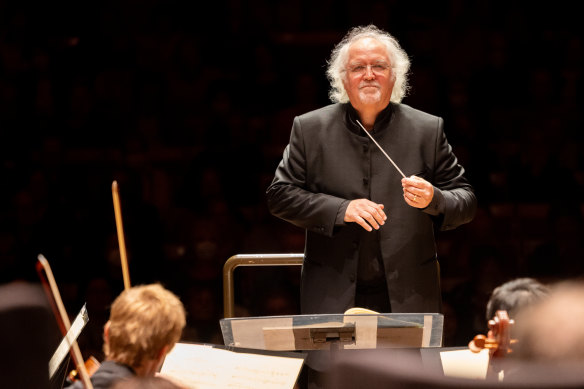
Sir Donald Runnicles conducts The Sydney Symphony Orchestra at the Sydney Opera House.Credit: SSO/supplied
After interval, Runnicles led the SSO in a beautifully shaped performance of music from Act III of Wagner’s Parsifal taken from the moment where Parsifal returns from his own descent into darkness to witness the literal and symbolic coming of Spring.
The ‘Dresden-Amen’ theme which occurs briefly at the start of this excerpt recalled, in its use of the first five notes of the scale, the theme Barley had returned to at the start of each movement of The Protecting Veil and also makes a hushed appearance in the final work, Mendelssohn’s Symphony No. 5 in D minor, Opus 107, ‘Reformation’.
The carefully nuanced, beautifully phrased performance that Runnicles led the SSO through avoided any hint of overdone religiosity. Its final movement explores the Lutheran hymn, ‘A mighty fortress is our God’ with worthy counterpoint and, at the end, blazing affirmation, which Runnicles and the SSO presented without bombast. Though curated around Good Friday, it was a program which opened contemplative musical spaces for listeners of all faiths and of no faith.
Psychedelic Frenzy
Ensemble Offspring
The Neilson, March 23
Reviewed by PETER McCALLUM
★★★★
Italian composer Fausto Romitelli died tragically from cancer in 2004, at age 41, giving him just 10 years longer than Schubert to make his musical mark. He did so, though that’s where the resemblance to Schubert ends.
His music combines dense, anarchic textures that draw on the complexity of European avant garde styles of the mid-20th and the hallucinatory wildness of rock music from what is sometimes called the “psychedelic era”. The result is not so much a thrash into oblivion as an exploration of psychological states in which strong ideas burst into the mind and then fragment and dissolve as though destroyed by their own violent energy.
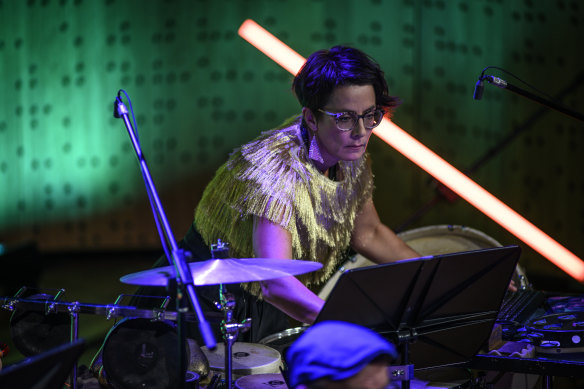
Ensemble Offspring’s Claire Edwardes.
This process leaves behind a sense of iridescence as though a new awareness has been born. Sydney had a chance to experience his approach in 2015 when Sydney Chamber Opera and Ensemble Offspring presented his opera An Index of Metals and Offspring returned to his work in this concert with his palendromically- titled ensemble piece Amok Koma (drawing its title from an album by German punk band Abwarts).
Amok Koma, for a heterogenous group of nine wind, string, keyboard and percussion players, starts with grand rhetorical chordal gestures that quickly begin to slide and smear before coming to rest on a pause. The idea is repeated, becoming more extreme and frenetic.
When things quieten at the end, only hushed filaments of sound remain (made ghostly with quiet whistles and blown wine bottles) like pale sunlight through a smoking ruin. The concert began with a very short, extremely hyperactive work, beijing, by Austrian composer Bernhard Gander for two saxophones.
Kate Moore’s Joyful Melodies for Marimba (Claire Edwardes) comprised undulating arpeggios in minimalist style with occasional connections and disjunctions of voice-leading.
Wang Lu’s Cloud Intimacy mixed distorted references to languorously sensual Romantic gestures of love (including quotations from Wagner’s Tristan and Isolde) with shrieking clarinets and frenetic typing, texting and musical representations of the right-swiping gestures with which modern love is dismissed.
Hannah Peel’s Neon, in three parts, started with brittle rhythmic patterns on the piano while the other players added brushed chords like an image caught fleetingly as one sweeps past. The second part combined plucked string notes and clicking atmospherics on a digital track with long flute notes and an improvisatory clarinet part to create a shimmering surface that evades depth.
The last part used sustained sounds receding into the distance, bringing to mind, in modern form, Robert Frost’s line, ‘I have looked down the saddest alleyways’, from the poem I have been one acquainted with the night.
ROCK
Wilco
Sydney Opera House, March 21
Reviewed by BERNARD ZUEL
★★★★½
Greatness is overrated and certainly overused. We elevate in emotion and remember in a glow and sometimes, years on, we realise, yeah, maybe it wasn’t quite that special.
So there’s a caveat to be placed on reviews like this that declare Wilco are one of the great bands and that this was one of the great (not perfect, but very close) shows. But dammit with the caveat, so much about this night thrilled to the core.
For long-time travellers there was a setlist that traversed their decades-long career as if it were a box of no-orange-ones family favourites. They dipped into their 1995 debut A.M. with the breezy ’60s 12-string guitar jangle and punchy drums of Box Full of Letters – which crowned the first hour – as comfortably as they approached last year’s trotting-paced Evicted, which has just enough of a hint of Raspberry Beret to cast sunlight on to its grey sky story.
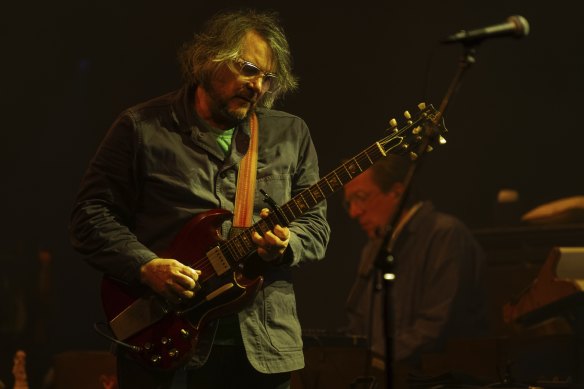
Jeff Tweedy’s vocals were simultaneously relaxed, aching, cutting and vibrant.Credit: Rhett Wyman
They fired up songs from the slightly better-known second album Being There, via the silver satin-tinged parenthetical double hit of Outtasite (Outta Mind) and I Got You (at the End of the Century) – which closed the night with a Who-like blend of midland rock fuelled by power pop – with the same ease they brought to the waltz shuffle and earned wisdom of 2022’s I Am My Mother.
For aficionados of the subtleties of rhythm there was John Stirratt (whose electric bass on Handshake Drugs was so warm and woody it sounded as if he were playing an upright) and Glenn Kotche (whose drums could hint and suggest through Cruel Country or invoke the clamour of collapsing new buildings in Via Chicago) to play forward and back like some musical Isaac Heeney.
Even if the opening seven-song bracket of laid-back country shapes, which began with the forlorn trans-urbanite Hell Is Chrome, was one or two songs too long, for lovers of the broadest range of Americana, Wilco can add to those the Randy Newman-ish Hummingbird, the folk charmer California Stars, the wistful bright rock of Heavy Metal Drummer, and the blend of resonator guitar, sound effects, decoupling breakdown and anxiety that squeezes into I Am Trying to Break Your Heart.
And for those for whom the possibilities of guitar remain open, there was the small thing of wonder that was the doubled solo in Side With the Seeds (Nels Cline and Pat Sansone entwined), the dovetailed climax of Bird Without a Tail/Base of My Skull (Cline and Sansone duelling into acceptance), and the closing-out triple-guitar feedback (Cline, Sansone and Jeff Tweedy in a siren call, not a revolt) of Handshake Drugs. All of which still bow down to Impossible Germany, where the liquid guitars pour honey as a prelude to Cline’s tour-de-force solo that in 10 minutes covered New Orleans and Oklahoma, New York and west Texas, Los Angeles and Macon.
I haven’t even mentioned Tweedy’s vocals, which were simultaneously relaxed, aching, cutting and vibrant, especially in the dedication dressed as a caress of Jesus, Etc. Or the pleasure coursing through The Late Greats that prepared the way for the shot of energy in the dark pointedness of A Shot in the Arm. Let alone the sense of lightness that moved two hours on stage into next to nothing.
Great, great band. Great, great show.
POP
Jessica Mauboy
Enmore Theatre, March 23
Reviewed by MICHAEL RUFFLES
★★★½
New album, new tour, new record label, same relentlessly enthusiastic Jessica Mauboy.
The effervescent R&B pop diva made her Enmore Theatre debut on Saturday in front of an adoring crowd, delivering belter after belter with the occasional ballad thrown in for good measure.

Jessica Mauboy performs at Enmore Theatre on Saturday.Credit: Girl in the Bandana – Jordy Pannowitz
Starting with the made-for-the-wedding-reception title track Yours Forever set the mood: optimistic, bright and polished pop from a seasoned and talented singer. The gospel-tinged Give You Love, last year a gold-certified single with Jason Derulo, was similarly uplifting.
Even the one about the neglectful ex-boyfriend (The Loneliest I Ever Was) and the one about heartbreak and missed opportunities (Little Too Late) end up being anthemic and empowering.
Mauboy sparkles so much you could be forgiven for thinking she was still trying to win Australian Idol after all these years. (Being runner-up doesn’t seem to have harmed her chart-topping career.)

Jessica Mauboy sparkles so much you could be forgiven for thinking she was still trying to win Australian Idol all these years later.Credit: Girl in the Bandana – Jordy Pannowitz
About eight songs in, my dance partner confessed she felt like she was in church. Mauboy might even have prompted an “amen” in response to the barnstorming Can I Get a Moment? if she had asked.
But it’s less a holy experience than a wholesome one, less Jesus Christ Superstar and more Carly Rae Jepsen.
The show’s main flaw, if it could be called that, is that Mauboy’s show is too smooth, too slick, too perfect. The songs seem too cookie-cutter for such a great singer. She’s all diamond and no rough.
A middle run of ballads and some wanders down memory lane and reality-TV show competitions from the Voice judge helped vary the momentum. She describes her latest work as her “most honest and most vulnerable” and it provides emotional highlights with the regretful Sorry and the stripped-back, grief-stricken Goodbye.
Mauboy also played it safe with the greatest-hits selection. Post-Idol chart-toppers Running Back and Burn were delivered with aplomb, the hedonistic Pop a Bottle (Fill Me Up) unbridled in its joy. For those firmly in the church of Mauboy, it was a rapture. For the rest of us, it was a bright, uplifting night.
The Booklist is a weekly newsletter for book lovers from books editor Jason Steger. Get it delivered every Friday.